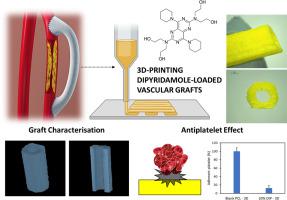Biomaterials Advances ( IF 5.5 ) Pub Date : 2021-08-14 , DOI: 10.1016/j.msec.2021.112375 Juan Domínguez-Robles 1 , Tingjun Shen 1 , Victoria A Cornelius 2 , Francesca Corduas 3 , Elena Mancuso 3 , Ryan F Donnelly 1 , Andriana Margariti 2 , Dimitrios A Lamprou 1 , Eneko Larrañeta 1

|
Cardiovascular disease (CVD) is a general term for conditions which are the leading cause of death in the world. Quick restoration of tissue perfusion is a key factor to combat these diseases and improve the quality and duration of patients' life. Revascularization techniques include angioplasty, placement of a stent, or surgical bypass grafting. For the latter technique, autologous vessels remain the best clinical option; however, many patients lack suitable autogenous due to previous operations and they are often unsuitable. Therefore, synthetic vascular grafts providing antithrombosis, neointimal hyperplasia inhibition and fast endothelialization are still needed. To address these limitations, 3D printed dipyridamole (DIP) loaded biodegradable vascular grafts were developed. Polycaprolactone (PCL) and DIP were successfully mixed without solvents and then vascular grafts were 3D printed. A mixture of high and low molecular weight PCL was used to better ensure the integration of DIP, which would offer the biological functions required above. Moreover, 3D printing technology provides the ability to fabricate structures of precise geometries from a 3D model, enabling to customize the vascular grafts' shape or size. The produced vascular grafts were fully characterized through multiple techniques and the last step was to evaluate their drug release, antiplatelet effect and cytocompatibility. The results suggested that DIP was properly mixed and integrated within the PCL matrix. Moreover, these materials can provide a sustained and linear drug release without any obvious burst release, or any faster initial release rates for 30 days. Compared to PCL alone, a clear reduced platelet deposition in all the DIP-loaded vascular grafts was evidenced. The hemolysis percentage of both materials PCL alone and PCL containing 20% DIP were lower than 4%. Moreover, PCL and 20% DIP loaded grafts were able to provide a supportive environment for cellular attachment, viability, and growth.
中文翻译:

使用 3D 打印开发用于预防血栓形成的载药心血管假体
心血管疾病 (CVD) 是世界上导致死亡的主要原因的疾病的总称。组织灌注的快速恢复是对抗这些疾病和提高患者生活质量和寿命的关键因素。血运重建技术包括血管成形术、支架放置或外科旁路移植术。对于后一种技术,自体血管仍然是最佳的临床选择。然而,许多患者由于以前的手术而缺乏合适的自体,并且通常不适合。因此,仍然需要提供抗血栓形成、新内膜增生抑制和快速内皮化的合成血管移植物。为了解决这些限制,开发了 3D 打印双嘧达莫 (DIP) 负载的可生物降解血管移植物。聚己内酯 (PCL) 和 DIP 在没有溶剂的情况下成功混合,然后 3D 打印血管移植物。使用高分子量和低分子量 PCL 的混合物来更好地确保 DIP 的整合,这将提供上述所需的生物学功能。此外,3D 打印技术提供了从 3D 模型制造精确几何结构的能力,从而能够定制血管移植物的形状或大小。所生产的血管移植物通过多种技术进行了充分表征,最后一步是评估它们的药物释放、抗血小板作用和细胞相容性。结果表明,DIP 在 PCL 基质中得到了适当的混合和整合。此外,这些材料可以提供持续和线性的药物释放,而不会出现任何明显的突释,或任何更快的初始释放速度 30 天。与单独的 PCL 相比,所有 DIP 负载血管移植物中的血小板沉积明显减少。单独的PCL材料和含有20% DIP的PCL材料的溶血百分比均低于4%。此外,PCL 和 20% DIP 负载的移植物能够为细胞附着、活力和生长提供支持性环境。











































 京公网安备 11010802027423号
京公网安备 11010802027423号